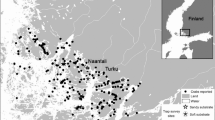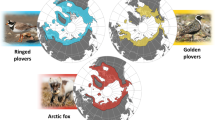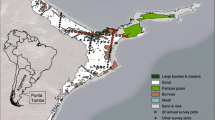Abstract
Non-native invasive species are one of the most serious threats to biodiversity and are considered the leading cause of extinction of several bird taxa, including seabirds. Introduced American mink (Neovison vison) have caused devastating effects on island populations of several colonial seabird species. In this study, we investigated the direct and indirect effects of mink on population dynamics and reproductive success of European shags (Phalacrocorax aristotelis) breeding at Illas Cíes, one of the most important colonies of the species in Southern Europe. A severe episode of mink predation on adult shags occurred in the year when mink arrived in the breeding colonies, though the number of shags killed dropped abruptly in subsequent years. We found that, after the arrival of mink, shags moved to nest-sites that afforded greater protection from carnivores. This shift caused a substantial reduction in mortality by predation, but probably entailed a cost in terms of their reproductive success because sites with lower levels of predation risk showed a higher risk of egg loss by nest flooding due to poorer drainage. Our study highlights that behavioural plasticity may allow shags to cope with invasive predators.




Similar content being viewed by others
References
Aebischer NJ (1986) Retrospective investigation of an ecological disaster in the shag, Phalacrocorax aristotelis: a general method based on long-term marking. J Anim Ecol 55:613–629
Aebischer NJ, Wanless S (1992) Relationships between colony size, adult non-breeding and environmental conditions for Shags Phalacrocorax aristotelis on the Isle of May, Scotland. Bird Study 39:43–52
Barros A, Álvarez D, Velando A (2013) Cormorán moñudo—Phalacrocorax aristotelis. In: Salvador A, Morales MB (eds) Enciclopedia Virtual de los Vertebrados Españoles. Museo Nacional de Ciencias Naturales, Madrid. http://www.vertebradosibericos.org. Accessed 24 June 2015
Barros A, Álvarez D, Velando A (2014) Long-term reproductive impairment in a seabird after the Prestige oil spill. Biol Lett. doi:10.1098/rsbl.2013.1041
Bennett PM, Owens IPF (1997) Variation in extinction risk among birds: chance or evolutionary predisposition? Proc R Soc Lond B 264:401–408
BirdLife International (2000) Threatened birds of the world. Lynx Edicions and BirdLife International, Barcelona
Bixler KS (2010) Why aren’t Pigeon Guillemots in Prince William Sound, Alaska, recovering from the Exxon Valdez oil spill? M.Sc. Thesis, Oregon State University, Corvallis, Oregon
Björsson TE, Heirstensson P (1991) Mink in southern Breidfjordur Bay. In: Macdonald D, Strachan R (eds) The mink and the water vole. Analyses for Conservation 7. Wildlife Conservation Research Unit and the Environment Agency, Oxford, pp 3–12
Blackburn TM, Cassey P, Duncan RP, Evans KL, Gaston KJ (2004) Avian extinction and mammalian introductions on oceanic islands. Science 305:1955–1958
Bolker BM, Brooks ME, Clark CJ, Geange SW, Poulsen JR, Stevens MHH, White JSS (2009) Generalized linear mixed models: a practical guide for ecology and evolution. Trends Ecol Evol 24:127–135
Bonesi L, Macdonald DW (2004) Evaluation of sign surveys as a way to estimate the relative abundance of American mink (Mustela vison). J Zool 262:65–72
Bonesi L, Palazón S (2007) The American mink in Europe: status, impacts, and control. Biol Conserv 134:470–483
Bonesi L, Chanin P, Macdonald W (2004) Competition between Eurasian otter Lutra lutra and American mink Mustela vison probed by niche shift. Oikos 106:19–26
Brzeziński M, Natorff M, Zalewski A, Zmihorski M (2012) Numerical and behavioral responses of waterfowl to the invasive American mink: a conservation paradox. Biol Conserv 147:68–78
Burnham KP, Anderson DR (2002) Model selection and multimodel inference. A practical information-theoretic approach. Springer, New York
Craik C (1995) Effects of North American mink on the breeding success of terns and smaller gulls in west Scotland. Seabird 17:3–11
Craik C (1997) Long-term effects of North American Mink Mustela vison on seabirds in western Scotland. Bird Study 44:303–309
Croxall JP, Rothery P (1991) Population regulation of seabirds: implications of their demography for conservation. In: Perrins CM, Lebreton JD, Hirons GJM (eds) Bird population studies, relevance to conservation and management. University Press, Oxford
Dunstone N (1993) The mink. T & AD Poyser Ltd, London
Eggers S, Griesser M, Nystrand M, Ekman J (2006) Predation risk induces changes in nest-site selection and clutch size in the Siberian jay. Proc R Soc Lond B 273:701–706
Fleming MA, Cook JA (2010) MtDNA and microsatellite DNA provide evidence of fur farm ancestry for mink populations in Prince William Sound, Alaska. Exxon Valdez Oil Spill Restoration Project 070853. Museum of Southwestern Biology, University of New Mexico, Albuquerque, NM
Folkestad AO (1982) The effect of mink predation on some seabird species. Viltrapport 21:42–49
Fontaine JJ, Martin TE (2006) Habitat selection responses of parents to offspring predation risk: an experimental test. Am Nat 168:811–818
Forstmeier W, Weiss I (2004) Adaptative plasticity in nest-site selection in response to predation risk. Oikos 104:487–499
Furness RW, Monaghan P (1987) Seabird ecology. Blackie, Glasgow
García-Díaz P, Lizana M (2013) Reproductive aspects of American minks (Neovison vison) in central Spain: testing the effects of prey availability. Mamm Biol 78:111–117
Gobster PH (2005) Invasive species as ecological threat: is restoration an alternative to fear-based resource management? Ecol Rest 23:261–270
Harfenist A, Ydenberg RC (1995) Parental provisioning and predation risk in rhinoceros auklets (Cerorhinca monocerata): effects on nestling growth and fledging. Behav Ecol 6:82–86
Hulme PE (2009) Trade, transport and trouble: managing invasive species pathways in an era of globalization. J Appl Biol 46:10–18
Lima SL (2009) Predators and the breeding bird: behavioural and reproductive flexibility under the risk of predation. Biol Rev 84:485–513
Little RC, Milliken GA, Stroup WW, Wolfinger RD, Schabenberger O (2006) SAS for mixed models, 2nd edn. SAS Institute Inc, Cary
Mainwaring MC, Hartley IR, Lambrechts MM, Deeming DC (2014) The design and function of birds’ nests. Ecol Evol 4:3909–3928
Martin TE (1993) Nest Predation and nest-sites: new perspectives on old patterns. Bioscience 43:523–532
Martínez-Abraín A, Velando A, Oro D, Genovart M, Gerique C, Bartolomé MA, Villuendas E, Sarzo B (2006) Sex-specific mortality of European shags after the Prestige oil spill: demographic implications for the recovery of colonies. Mar Ecol Prog Ser 318:271–276
McNeely JA (2005) Human dimensions of invasive alien species. In: Mooney HA, Mack RN, McNeely JA, Neville LE, Schei PJ, Waage JK (eds) Invasive alien species: a new synthesis. Island Press, Washington
Melero Y, Palazón S (2011) Visón americano—Neovison vison. In: Enciclopedia Virtual de los Vertebrados Españoles. Salvador A, Cassinello J (ed) Museo Nacional de Ciencias Naturales, Madrid. http://www.vertebradosibericos.org/. Accessed 20 May 2015
Mooney HA, Hobbs RJ (2000) Invasive species in a changing world. Island Press, Washington DC
Nelson BJ (2006) The pelecaniformes. Oxford University Press, Oxford
Nordström M, Högmander J, Laine J, Nummelin J, Laanetu N, Korpimäki E (2003) Effects of feral mink removal on seabirds, waders and passerines on small islands in the Baltic sea. Biol Conserv 109:359–368
Opermanis O, Mednis A, Bauga I (2001) Duck nests and predators: interaction, specialisation and possible management. Wildl Biol 7:87–96
Oro D, Pradel R, Lebreton JD (1999) The effects of nest predation and food availability on life history traits in Audouin’s gull. Oecologia 118:438–445
Pereira P (2006) Estudio de la metodología para el control de la población de visón americano en el archipiélago de Sálvora en el Parque Nacional Islas Atlánticas de Galicia. Parque Nacional Islas Atlánticas de Galicia (unpublished report)
Quillfeldt P, Schenk I, McGill RAR, Strange IJ, Masello JF, Gladbach A, Roesch V, Furness RW (2008) Introduced mammals coexist with seabirds at New Island, Falkland Islands: abundance, habitat preferences and stable isotope analysis of diet. Polar Biol 31:333–349
Ratcliffe N, Craik C, Helyar A, Roy S, Scott M (2008) Modelling the benefits of American Mink Mustela vison management options for terns in west Scotland. Ibis 150:114–121
Regehr HM, Rodway MS, Montevecchi WA (1998) Antipredator benefits of nest-site selection in Black-legged Kittiwakes. Can J Zool 76:910–915
Romero R, Piorno V (2012) Plan de control de visón americano (Neovison vison) en el Parque Nacional de las Islas Atlánticas de Galicia. In: Proceedings of the 7th European conference on biological invasions. Pontevedra (Spain)
Russell RW (1999) Comparative demography and life history tactics of seabirds: implications for conservation and marine monitoring life in the slow lane. Ecology and conservation of long-lived marine animals. Am Fish Soc Sympos 23:51–76
Saether BE, Bakke O (2000) Avian life history variation and contribution of demographic traits to the population growth rate. Ecology 81:642–653
Schüttler E, Ibarra JT, Gruber B, Rozzi R, Jax K (2009) Abundance and habitat preferences of the southernmost population of mink: implications for managing a recent island invasion. Biodivers Conserv 19:725–743
Short J, Kinnear JE, Robley A (2002) Surplus killing by introduced predators in Australia—evidence for ineffective antipredator adaptations in native prey species? Biol Conserv 103:283–301
Travers M, Clinchy M, Zanette L, Boonstra R, Williams TD (2010) Indirect predator effects on clutch size and the cost of egg production. Ecol Lett 13:980–988
Vidal-Figueroa T, Delibes M (1987) Primeros datos sobre el visón americano (Mustela vison) en el Suroeste de Galicia y Noroeste de Portugal. Ecología 1:145–152
Velando A, Álvarez D (2004) Cormorán moñudo, Phalacrocorax aristotelis aristotelis. In: Madroño A, González C, Atienza JC (eds) Libro Rojo de las Aves de España. Dirección General para la Biodiversidad-SEO/BirdLife, Madrid, pp 60–62
Velando A, Freire J (2001) Can the central-periphery distribution become general in seabird colonies? Nest spatial pattern in the European Shag. Condor 103:544–554
Velando A, Freire J (2002) Population modelling of European shag at their southern limit: conservation implications. Biol Conserv 107:59–69
Velando A, Freire J (2003) Nest-site characteristics, occupation and breeding success in the European shag. Waterbirds 26:473–483
Velando A, Marquez JC (2002) Predation risk and habitat selection in the inca tern (Larosterna inca). Can J Zool 80:1117–1123
Velando A, Munilla I (2008) Plan de Conservación del Cormorán Moñudo en el Parque Nacional de las Islas Atlánticas. Universidade de Vigo, Spain (unpublished report)
Velando A, Ortega-Ruano JE, Freire J (1999) Chick mortality in European shag Stictocarbo aristotelis related to food limitations during adverse weather events. Ardea 87:51–59
Velando A, Álvarez D, Mouriño J, Arcos F, Barros A (2005a) Population trends and reproductive success of the European shag Phalacrocorax aristotelis on the Iberian Peninsula following the Prestige oil spill. J Ornithol 146:116–120
Velando A, Munilla I, Leyenda PM (2005b) Short-term indirect effects of the Prestige oil spill on a marine top predator: changes in prey availability for European shags. Mar Ecol Prog Ser 302:263–274
Velando A, Barros A, Moran P (2015) Heterozygosity–fitness correlations in a declining seabird population. Mol Ecol 24:1007–1018
Vitousek PM, D’Antonio CM, Loope LL, Rejmánek M, Westbrooks R (1997) Introduced species: a significant component of human-caused global change. N Z J Ecol 21:1–16
Zuberogoitia I, Zabala J, Martínez JA (2006) Evaluation of sign surveys and trappability of American mink. Consequences for management. Fol Zool 55:257–263
Acknowledgments
We are grateful to the staff at the Parque Natural Illas Cíes and Parque Nacional Illas Atlánticas de Galicia for logistic support all over the study period, especially to Ramón Nogueira, José Antonio Fernández Bouzas, Vicente Piorno, Susana Torres and Gonzalo Puerto. We are especially grateful to Beatriz Gamallo, Francisco Docampo, Carmen Díaz, Antonio Sampedro, José Manuel Sanchez for their assistance in fieldwork. We thank Alejandro Martinez-Abraín and one anonymous reviewer for their constructive comments, which helped us to improve the manuscript. Permissions were guaranteed by Xunta de Galicia and Parque Nacional Illas Atlánticas de Galicia. Finance was provided by the Spanish Ministerio de Medio Ambiente (Organismo Autónomo Parques Nacionales, 48/2005; 275/2011). Ignacio Munilla was financially supported by an Isidro Parga Pondal fellowship (Xunta de Galicia).
Author information
Authors and Affiliations
Corresponding author
Electronic supplementary material
Below is the link to the electronic supplementary material.
Rights and permissions
About this article
Cite this article
Barros, Á., Romero, R., Munilla, I. et al. Behavioural plasticity in nest-site selection of a colonial seabird in response to an invasive carnivore. Biol Invasions 18, 3149–3161 (2016). https://doi.org/10.1007/s10530-016-1205-3
Received:
Accepted:
Published:
Issue Date:
DOI: https://doi.org/10.1007/s10530-016-1205-3




